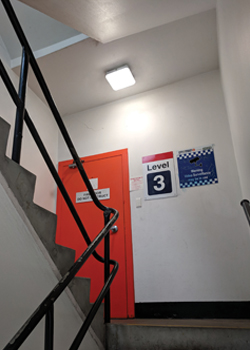How are emergency light classifications assigned & how are they used?

Australian Standard AS/NZS 2293 series covers the system design, installation, operation, service, maintenance, and production of emergency lights & exit signs. Here, we briefly outline the emergency luminaire testing & classification process, which provides maximum spacings between emergency lights for a range of mounting heights.
Emergency Lighting Requirement
Australian Standard AS/NZS 2293.1:2018 specifies a minimum light level of 0.2 lux with a minimum average of 0.5 lux at floor level under emergency lighting conditions. For stairwells, this should be a minimum of 1 lux. This emergency light level should be maintained for a minimum of 90 minutes upon failure of power supply to normal lighting. The level of light at floor or the tread of a step depends upon on the lumen output & light distribution of the fitting and the mounting height of the fitting above floor level.
How are emergency light fittings assigned classifications?
Emergency light fittings are tested for thermal & optical performance as per the requirements of AS/NZS 2293.3:2018. Classifications are assigned in alpha numeric formats wherein the alphabet is derived from the shape of the photometric curve & numeric is derived from the luminous intensity of the fitting. Fittings with asymmetrical light distributions are assigned two different classifications along the two directions (x & y axes or C0-180 & C90-270 plane) of light spread around the luminaire. For example, a symmetrical satellite/spitfire emergency light can have a single emergency classification of D50, whereas a batten with asymmetric distribution can have a double classification of C0-180: D80 & C90-270: D40.
The Alphabetical classifications can vary from Class A to Class E & numeric value can vary from 1 to 800. Class D Classification is most commonly used while designing spaces for emergency layouts. Higher the numeric value after the alphabet, higher is the luminous intensity of the fitting.
This testing should only be done by labs accredited by NATA or equivalent bodies for the AS/NZS 2293.3 standard.
How are the emergency classifications used in emergency layout design?
AS/NZS 2293.1:2018 mentions two approaches for emergency layout design. First being spacing rules & other being illuminance calculations. Spacing rules are widely followed for emergency layout design as they are pre-validated by Standards Australia for maximum allowable distances between emergency lights. Scope for error while following spacing rules is much lesser than illuminance calculations which can vary depending upon accuracy of lighting model, software utilized, experience of lighting designer & correct application of the standard.
Tables E1 to E5 and F1 to F5 of AS 2293.1:2018 provide maximum allowable distance between emergency lights as per their mounting heights and their assigned classification through AS/NZS 2293.3:2018 testing.
Refer to our product datasheets for Emergency Classifications of Chamaeleon III, Chamaeleon Eco, Chamaeleon Deco, Chamaeleon Deco 2, Mirador Range & Vico emergency lights.
Contact us for preparing a compliant emergency lighting design for your new or retrofit project. enLighten’s lighting designer is a part of the Technical Committee that is responsible for development & updates to AS/NZS 2293 series of standards on emergency lighting.
Technical Articles
Help us tailor your experience
We’d love to better understand who’s visiting. This isn’t data collection, just a quick way to help us design a better site for you.






